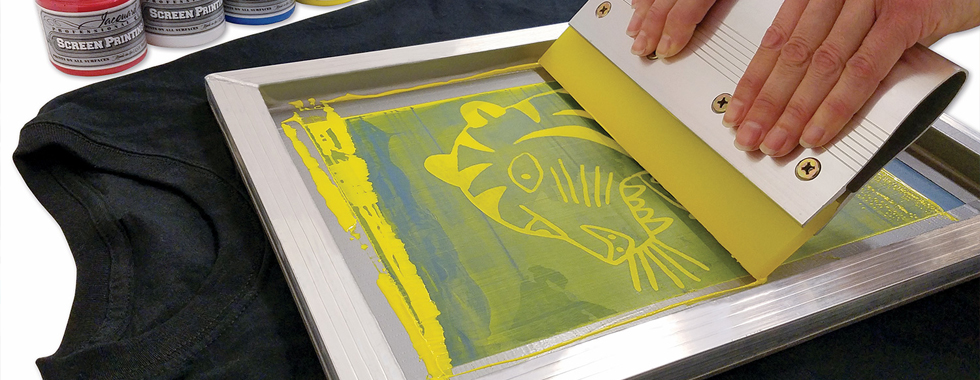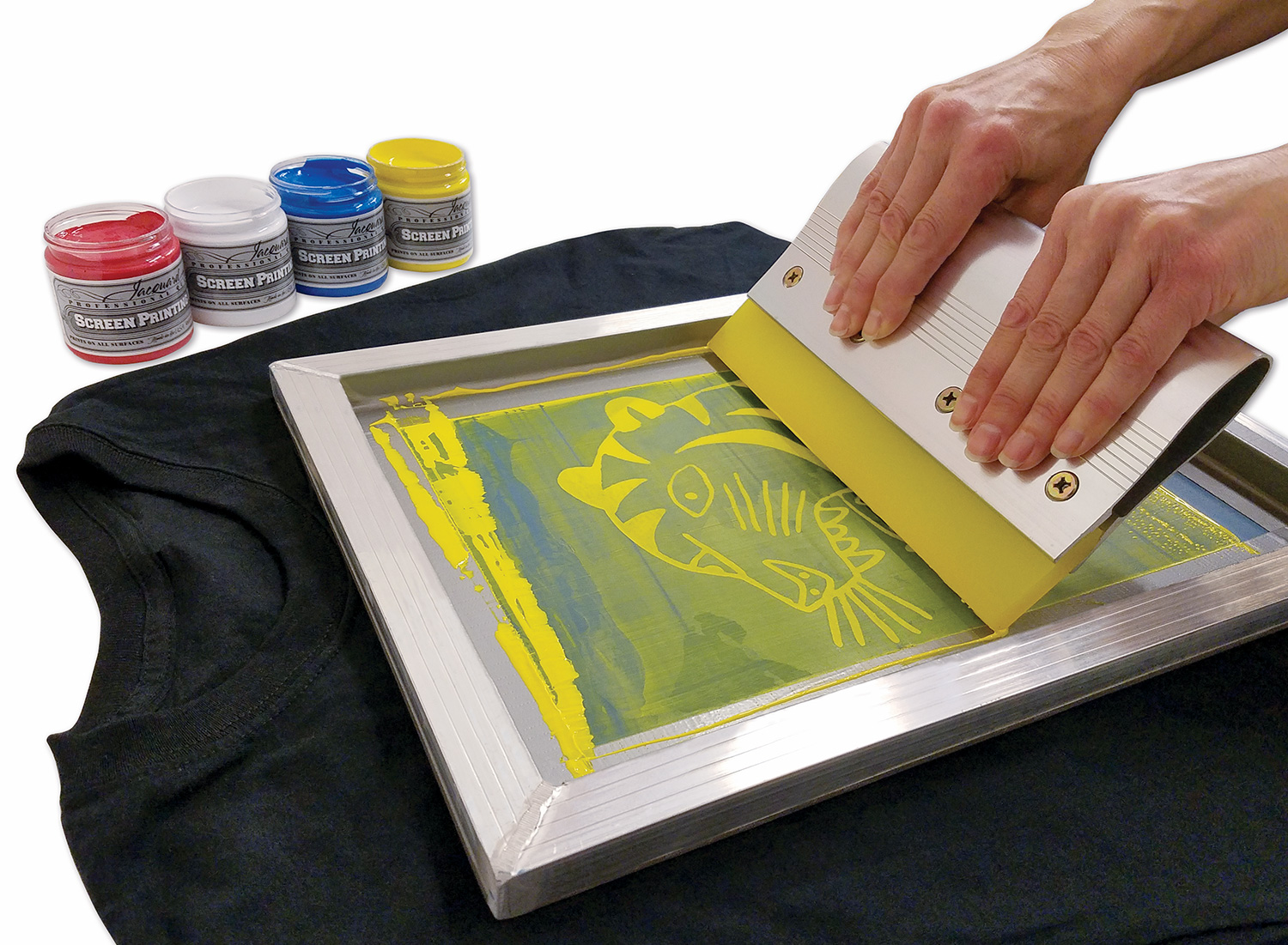Discover the Numerous Types of Screen Printing Techniques for Your Following Project
Screen printing uses a varied series of methods that can improve any kind of creative task. From typical techniques like serigraphy to contemporary developments such as direct-to-garment printing, each method has its distinct benefits. Specialty choices, including metal and environmentally friendly inks, present even a lot more possibilities. Recognizing these techniques can considerably affect the final outcome. The obstacle lies in picking the most ideal technique for certain demands and desired effects. What aspects should one take into consideration?

The Fundamentals of Screen Printing
Screen printing may appear complicated, it is fundamentally a simple process that entails moving ink via a mesh screen onto different surfaces. The technique starts with the development of a stencil, which specifies the layout to be printed. This pattern is affixed to a mesh screen, typically constructed from polyester or nylon. When the pattern is in location, ink is related to the screen and pushed via the mesh utilizing a squeegee, causing the preferred pattern being published on the underlying material.
Screen printing can be carried out on a variety of substratums, including plastic, textile, and paper, making it a functional selection for numerous jobs. The procedure enables intricate layouts and vivid shades, making it popular in markets such as art, marketing, and style. Recognizing these essentials furnishes people with the foundational knowledge needed to check out even more advanced techniques in screen printing.
Typical Screen Printing Techniques
Typical screen printing strategies have actually been utilized for centuries, protecting the workmanship and artistry of this method. This technique utilizes a mesh screen to move ink onto a substratum, such as material or paper, permitting vivid and lasting styles. The process starts with creating a stencil, which blocks particular areas of the screen to control where the ink will certainly be used.
One popular technique is serigraphy, frequently made use of for restricted editions and creative prints. One more is making use of water-based inks, which are environmentally friendly and give a soft feel on textiles - 10:9 Design Texas. Furthermore, conventional techniques can consist of hands-on printing, where artisans apply ink with a squeegee, making certain accuracy and interest to detail
These methods continue to be valued in the market for their responsive high quality and the one-of-a-kind textures they produce, appealing to both consumers and creators who value the heritage of screen printing.
Digital Screen Printing Innovations
As the demand for faster production and personalization in the printing sector has surged, electronic screen printing advancements have emerged as a game-changer. This technology blends standard screen printing methods with digital processes, enabling fast prototyping and elaborate designs that were previously hard to attain. One substantial improvement is the introduction of direct-to-garment (DTG) printing, which promotes top notch, full-color prints on various textiles without the need for screens. Additionally, developments in ink formulations have caused eco-friendly options that maintain dynamic colors while minimizing ecological influence. Using automated systems even more simplifies production, reducing labor costs and boosting accuracy. These advancements not just cater to tiny set orders and personalized layouts yet likewise enable for quicker turn-around times, making them perfect for businesses concentrated on conference customer needs in a hectic market. Digital screen printing, subsequently, stands for a necessary development in the domain name of printing strategies.
Specialty Screen Printing Methods
Checking out specialty screen printing methods exposes a diverse variety of techniques that press the limits of imagination and performance in the printing industry. Among these, glow-in-the-dark inks provide an one-of-a-kind visual impact, making styles come to life in low-light conditions. Metal inks, known for their sparkling surface, add a touch of luxury to printed products. One more innovative method is discharge printing, which eliminates dye from the material instead of adding ink, resulting in a soft, vintage feeling. High-density printing produces an elevated appearance externally, improving tactile engagement. Additionally, water-based inks are gaining appeal for their lively shades and decreased ecological effect. Each of these specialized methods satisfies details design requirements, making it possible for brands and musicians to produce standout items that resonate with their target markets. By leveraging these yard signs printed techniques, services can elevate their screen printing tasks to brand-new heights, guaranteeing remarkable impressions.
Eco-Friendly Screen Printing Options
Environment-friendly screen printing options are obtaining grip as the sector moves towards sustainability. Lasting ink choices and making use of naturally degradable products are key parts in reducing the ecological influence of the printing procedure. By taking on these practices, screen printers can contribute to a much more sustainable future while keeping high-quality outcomes.
Sustainable Ink Selections

Biodegradable Materials Use
As the screen printing industry develops, the unification of eco-friendly materials is ending up being significantly vital for environmentally conscious practices. Producers and developers are now discovering inks and substrates made from natural, eco-friendly sources that disintegrate a lot more successfully than traditional counterparts. These biodegradable choices lower plastic waste and minimize environmental effect, aligning with the growing need for lasting items.
Usual instances include water-based inks and natural cotton materials, both of which decrease unsafe chemicals and promote eco-friendliness. Brand names that embrace these products commonly improve their market charm, bring in customers that focus on sustainability. As understanding of ecological issues remains to increase, the change in the direction of biodegradable products in screen printing is most likely to get momentum, fostering a greener market requirement.
Picking the Right Method for Your Project
Exactly how can one figure out one of the most appropriate screen printing technique for a certain task? The decision hinges on several elements, including the product to be printed on, the intricacy of the layout, and the desired manufacturing quantity - 10:9 Design Company. Direct-to-garment printing is suitable for intricate layouts with countless colors, while standard screen printing excels for bigger runs of less complex graphics.
Additionally, factor to consider of the end-use of the printed item is crucial. For exterior applications, strategies that supply longevity and climate resistance, such as plastisol ink, might be chosen. On the other hand, environmentally-conscious tasks may gain from water-based inks or biodegradable products.
Ultimately, comprehending the job's unique requirements enables an enlightened choice, ensuring both visual appeal and practical longevity. By assessing layout intricacy, product compatibility, and production range, one can successfully pick the most proper screen printing method to fulfill their job's goals.
Often Asked Inquiries
What Is the History of Screen Printing?
Screen printing came from ancient China around 1000 ADVERTISEMENT, developing with Japan and Europe. By the 20th century, it came to be preferred in commercial art and fashion, changing exactly how styles were generated and distributed around the world.

Exactly how Do I Prepare Art Work for Screen Printing?
To prepare art work for screen printing, one should guarantee high resolution, make use of an ideal shade setting, create separate layers for each and every shade, and convert message to outlines, assuring compatibility with the printing procedure and preferred end result.
What Materials Are Ideal for Screen Printing?
The most effective materials for screen printing include high-quality inks, sturdy displays, and appropriate substrates like cotton, polyester, or blends. In addition, making use of proper emulsion and mops can enhance the printing procedure and results.
Can I Evaluate Publish in the house?
Yes, screen printing at home is possible. With the right products, arrangement, and techniques, individuals can develop top notch prints. Nevertheless, mindful consideration of workspace and tools is necessary for effective outcomes.

What Prevail Errors in Screen Printing?
Usual mistakes in screen printing consist of inappropriate exposure times, inadequate ink uniformity, imbalance of screens, not enough cleaning of products, and disregarding to examine prints. These errors can compromise the top quality and accuracy of the end product.
Screen printing may appear complex, it is fundamentally a straightforward procedure that includes moving ink via a mesh screen onto numerous surface areas. As the need for faster manufacturing and modification in the printing industry has actually surged, digital screen printing advancements have emerged as a game-changer. Discovering specialty screen printing approaches reveals a varied array of methods that push the boundaries of creative thinking and functionality in the printing market. The ideal products for screen printing consist of top notch inks, durable screens, and appropriate substrates like cotton, polyester, or blends (10:9 Design contact). Common blunders in screen printing include inappropriate direct exposure times, poor ink consistency, misalignment of screens, insufficient cleansing of products, and ignoring to test prints